Telephone Your Telegrams
by Hans Kettenburg
Reprinted from "Crown Jewels of the Wire", August 1985, page 21
With this issue I'll be starting a new column dealing with "Go-Withs," all
those compatible collectibles that compliment an insulator collection. Many
collectors have become interested in telephone and telegraph signs to display
with their insulators and these have become some of the most popular go-withs. I
will be concentrating on the telegraph signs, because of the wide exposure the
telephone signs have already received in past issues of Crown Jewels and also in
Bob Alexander's fine publication "A Collectors Guide to Antique Telephone
Advertising." Check this excellent book out if you have not yet done so.
Some other go-withs we'll be seeing in the future issues of Crown Jewels will
be telegraph apparatus such as keys, sounders, relays, registers, plus a few
telephones and messenger call-boxes.
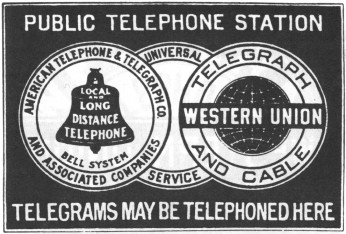
Reproduced from "A Collectors Guide to Antique Telephone
Advertising" by Bob Alexander. (Used with permission.)1. A very desirable
sign for both the telephone OR telegraph sign collector. Comes in blue
and white enamel on steel. 8" x 12" or 12" x 18" one-sided, flat;
and 12" x 18" two-sided, flanged.
|
Flange signs for display at automatic coin box pay station agencies, where
telegraph tolls may be deposited by sender.
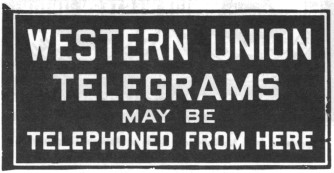
2. Blue & White Enamel on Steel
Sizes - 9" x 18"
12" x 24"
15" x 30"
18" x 36"

Reproduced from "A Collectors Guide to Antique Telephone
Advertising" by Bob Alexander. (Used with permission)
3. Blue & White Enamel on Steel, Flanged Two-Sided
Sizes -- 4" x 18"
5-1/2" x 24"
6-3/4" x 30"
8" x 36"
|
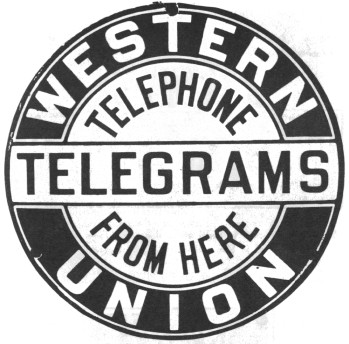
4. This is a special treat for the sign collector for several reasons. Its shape, when most signs
are rectangles, is a slightly convex circle. It is also a three color sign;
red, white and blue. (Telephone
Telegrams From Here, is in red; Western Union is white on a blue field)
This sign is used for outside display on window or below window at
automatic coin box pay station agencies. Red, white, and blue enamel on
steel. 7-3/4" in diameter. I have also seen this design on a larger,
flat sign, maybe 10" or 12" in diameter. Red, white and blue lithographed
on light gauge steel.
|
Wood items such as poles, cross arms, side brackets (when out hunting
insulators, don't leave that wood behind, bring it home and display your
insulators on it) plus framed telegraph envelopes and messages add interest to
your collection. Telephone and telegraph badges can be placed on a display board
to show them off. One of the earliest telegraphic inventions that allowed everybody
easy access to the electric wire was the fire alarm box. We'll be looking at
some of the fire alarm telegraph apparatus; old electrical catalogues and books
dealing with telephone and telegraph history; photographs and illustrations of
early pioneers of the communications industry; and even battery jars, etc. Well,
that will give you some idea of what to look forward to in the coming months.
#5, 6, 7, & 8 -- Used for signing company-owned self-service telephone
booths.

5. To be attached to panel above door on exterior of booth.
Lithographed in
blue and white on sheet steel. Size 8" x 36"
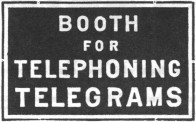
6. For use on interior of type 1-B folding door booth.
Lithographed in blue
and white on steel. Size 7-1/2" x 12"

7. For use on interior of type 1-B folding door booth.
Lithographed in blue
and white on steel. Size 4-1/2" x 12"
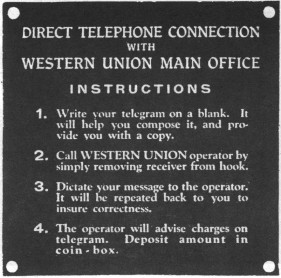
8. For use on interior wall above the telephone shelf.
Lithographed in Blue
and White on Sheet Steel. Size 5" x 5"
This first issue we'll look at telegraph signs that reminded people that they
could telephone their telegrams. This can be done at company agencies or company
owned phone booths. Sign #1 is the earliest design that I'm aware of, it being
used roughly between 1911-1922. (Correct me if I am wrong, your input is needed
and welcome.) Signs #2-#8 are shown in the Western Union Commercial Bulletin No.
69, titled Standard Signs. August 1, 1925. That gives an idea of the age of
those signs. The Postal sign (#9) is from the early 30's to early 40's? The
Western Union candlestick phone sign (#10) is probably from the 1940's?
Any help you readers out there can give me would be most appreciated.
Accurate dates when these signs were used is needed. Do you have any signs or
know of any that would fit in this group? If so, I'd like to hear about them or
see a photograph.
My main goal concerning this new column will be to provide large, clear
photographs every month for us all to enjoy. What's our next topic? I don't know
yet -- have to wait and see.
Thank you, Bob Alexander, for your help in allowing me to use several
illustrations from your book, "A Collectors Guide to Antique Telephone
Advertising."
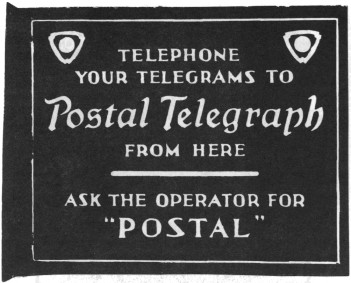
9. Blue and White Enamel on Steel, two-sided, flanged sign.
Size 8-1/2" x 10-3/4"
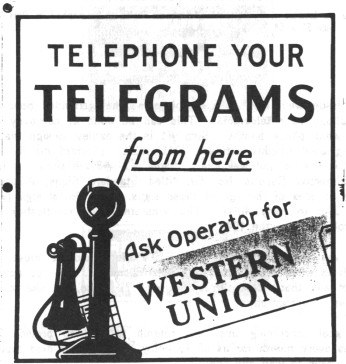
10. Here is a real prize for the phone sign or telephone sign
collector -- a four
color sign! (Telephone your telegrams from here and the border stripe am in blue.
The candlestick phone and Western Union are in black. The message blank is yellow
and all is on a white background.) This is a flanged, two-sided sign. Size
18" x 19-1 i/2". I have also seen design on a smaller one-sided
sip -- lithographed on tin. |
| 